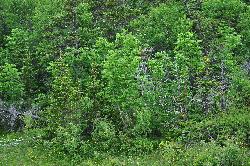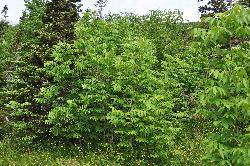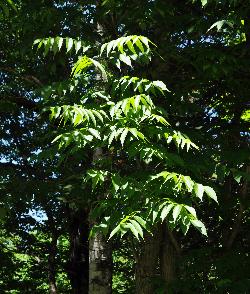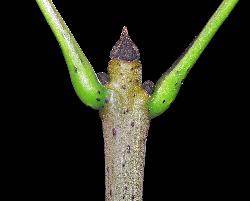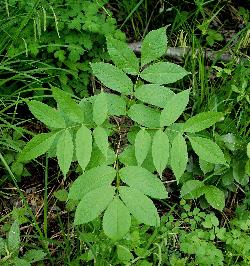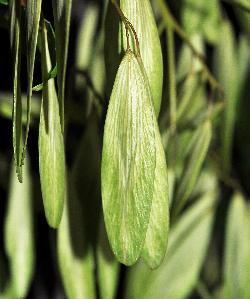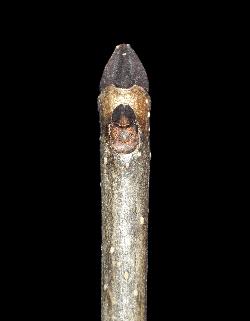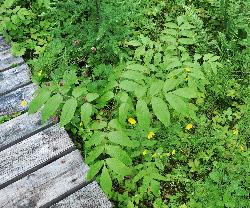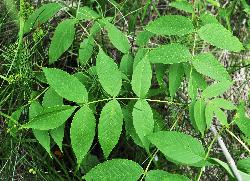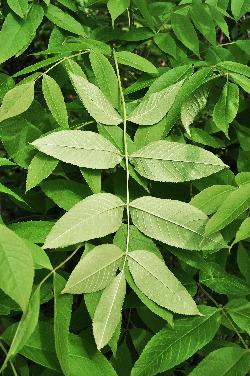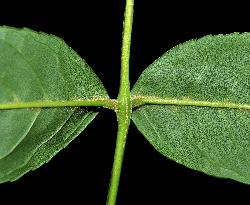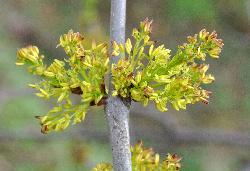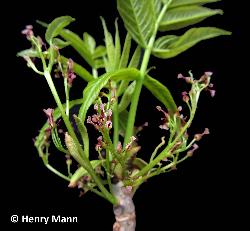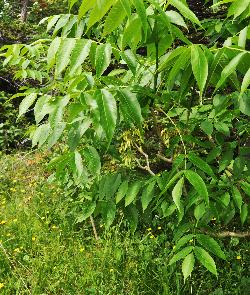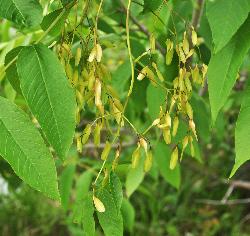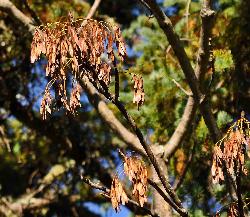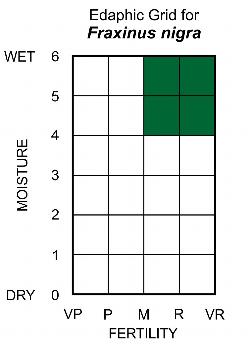Fr: frêne noir, frêne gras, frêne de grève
Oleaceae - Olive Family
Note: Numbers provided in square brackets in the text refer to the image presented above; image numbers are displayed to the lower left of each image.
General: A small deciduous tree [1–4], to 20 m tall with a d.b.h. of 50 cm on the mainland, but seldom exceeding 16 m tall in Newfoundland (Deichmann 1989). Black ash is a slow-growing, shade-intolerant species, with a shallow, but wide-spreading, root system that can withstand flooding. Black ash is usually found growing in swamps, treed fens, or other seasonally flooded habitats with muck soils. In mainland Canada, black ash wood is used by Mi'kmaq and other First Nations people to construct hand-woven baskets (Butland 2001, Hill-Forde 2004).
Key Features:
Twigs are stout with a dark brown conical terminal bud and rounded lateral buds that are locate a short distance below the terminal bud [5].
- Leaves are opposite and pinnately compound, with 7–11 sessile leaflets; tufts of cinnamon brown hairs are located at the base of each leaflet [6].
- The fruits are clusters of narrowly elliptic, blunt-tipped winged samaras; the wing on black ash fruit extends to the base, completely surrounding the seed [7].
Stems/twigs: Twigs are greyish-brown, stout, terete in cross-section, and glabrous. Buds are opposite, dark brown to blackish, with 1–2 pairs of scurfy bud scales that appear velvety; the terminal bud is conical, 4–10 mm long, and the first pair of smaller rounded lateral buds are attached a few millimetres below the terminal bud [8]. Leaf scars are large and nearly oval, with the top of the scar flat to slightly concave; bundle trace scars are numerous and form an open circle within the leaf scar [8–9]. Trunks are generally straight and have light grey to greyish-brown bark with narrow furrows and corky ridges.
Leaves: Opposite or nearly so, pinnately compound, with 3–5 pairs of sessile, opposite leaflets and a terminal leaflet, for a total of 7–11 leaflets [10–12]. The rachis is 15–30 cm long, and the petiole and rachis are glabrous. Leaflets are elliptic, lanceolate, or ovate, 10–14 cm long, dark green, and glabrous above. The lower blade surface of leaflets is slightly paler and glabrous [13], except for tufts of cinnamon-brown hairs located at the base of each leaflet [14]. Leaflet apices taper gradually to a sharp (acuminate) point, bases are tapering (cuneate) to rounded. Margins are serrate with low, blunt to rounded teeth. Leaves turn yellow or reddish brown in autumn and the leaves tend to drop with the leaflets intact.
Flowers: Unisexual, usually dioecious, occasionally polygamous, with small inconspicuous male and female flowers on separate trees, or with perfect flowers (with both male and female organs) occurring with the unisexual flowers. Male inflorescences have densely branched clusters of flowers that lack perianth parts, each flower consisting of only 2 reddish-brown to yellow stamens [15]. Female flowers are borne in open terminal or axillary clusters (panicles) and lack perianth parts [16]. Flowers bloom with the emerging leaves. Pollination is by wind (anemophily), but beetles are known to eat black ash pollen.
Fruit: A winged samara, oblong to narrowly elliptic, and 1-seeded [17–18]. Samaras measure 2.5–4 cm long; the broad flat to twisted wing is blunt to slightly notched at the apex and extends to the base of the fruit body (seed case), which is oval in cross-section, and about 2 cm long. Immature green to yellow samaras become brown at maturity, occur in pendant clusters in the fall [19], and disperse by wind (anemochory) throughout the winter.
Ecology and Habitat: Within the province, black ash is absent from Labrador and is restricted to small populations in western Newfoundland, approximated by a triangular area that extends from Stephenville east to Springdale and north to Bonne Bay. It occurs on moist to somewhat wet nutrient-rich soils. Black ash is a slow-growing tree that is shade-intolerant and prefers open habitats. On mainland Canada, it is a small to medium-sized tree that can grow to 20–25 m in height. In Newfoundland, the largest black ash occur in the Lower Humber valley and attain a height of about 16 m, but in other locations, it is frequently found as a tall shrub or small tree less than 10 m tall (Deichmann 1989). It often grows in clumps arising from root sprouts.
Edaphic Grid: See image [20]: the Edaphic Grid for Fraxinus nigra.
Forest Types: Due to the scarcity of black ash in Newfoundland, it is not included in the forest vegetation classification. One would expect to find black ash in the following associations or subassociations, occupying nutrient-rich somewhat-wet to wet soil conditions.
- Abietum rubetosum - wet variant (Rubus-Balsam Fir Forest Subassociation - wet variant)
- Carici-Piceetum (Carex-Black Spruce Fen Association)
Succession: Black ash is a shade-intolerant species that grows more slowly than many of its competitors. Therefore, it is probably restricted to naturally open wet habitats and would rarely occur within closed canopy mature conifer forests.
Distribution: A map published by Deichmann (1989) shows natural black ash populations in western Newfoundland in the Lower Humber River, Indian River, Lomond, Gallants, and Barachois Park. Planted populations occur on the Avalon Peninsula. Black ash ranges from western Newfoundland, west to southeastern Manitoba and eastern North Dakota, south to Iowa, east to southern Indiana, Ohio, and West Virginia, and north from northern Virginia to Delaware and New Jersey (Wright and Raucher 1990).
Similar Species: There are no other ash (Fraxinus) species native to Newfoundland and Labrador, but the leaves of black ash may be confused with those of mountain ash (Sorbus decora (Sarg.) C.K. Schneid. or Sorbus americana Marshall), which have alternate leaves with more sharply serrate leaflet margins and broad clusters of small white-petalled flowers, followed by clusters of small red berry-like pomes.
In urban areas, the European ash (Fraxinus excelsior L.) is often planted as an ornamental; it can be differentiated from black ash by its 3–6 pairs of sessile, opposite leaflets, and its nearly black terminal and lateral buds, larger ovoid lateral buds, and leaf scars that are hemispherical.



